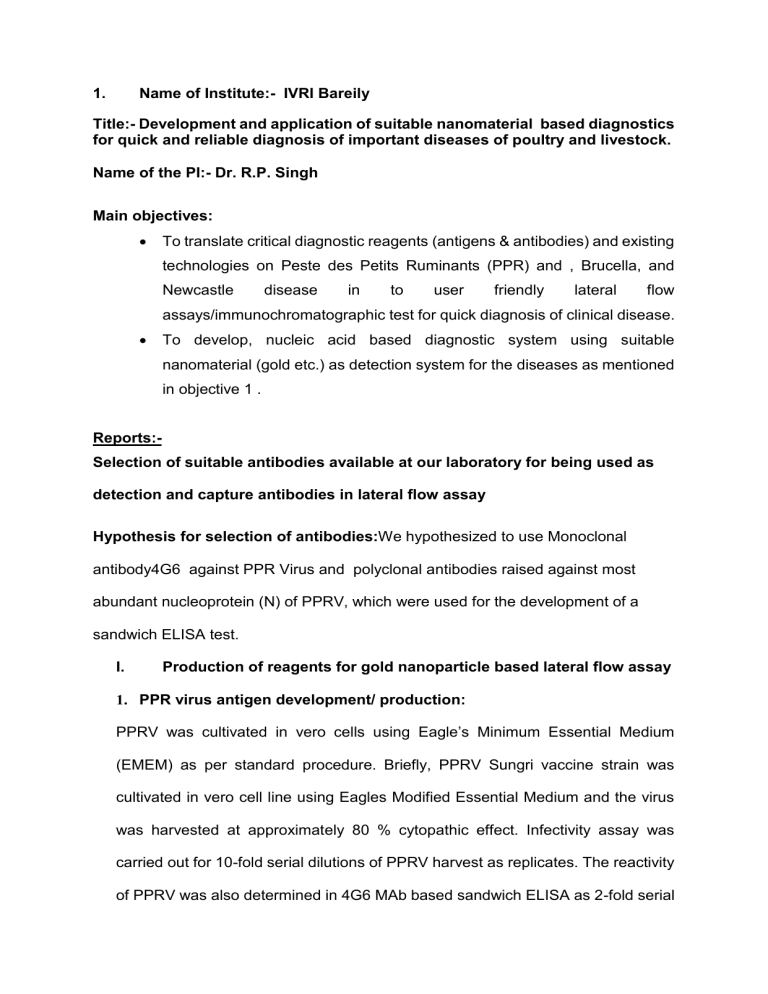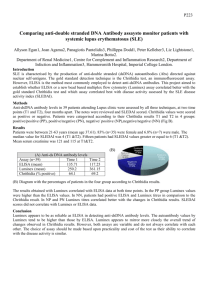IVRI Bareily

1. Name of Institute:- IVRI Bareily
Title:- Development and application of suitable nanomaterial based diagnostics for quick and reliable diagnosis of important diseases of poultry and livestock.
Name of the PI:- Dr. R.P. Singh
Main objectives:
To translate critical diagnostic reagents (antigens & antibodies) and existing technologies on Peste des Petits Ruminants (PPR) and , Brucella, and
Newcastle disease in to user friendly lateral flow assays/immunochromatographic test for quick diagnosis of clinical disease.
To develop, nucleic acid based diagnostic system using suitable
Reports:- nanomaterial (gold etc.) as detection system for the diseases as mentioned in objective 1 .
Selection of suitable antibodies available at our laboratory for being used as detection and capture antibodies in lateral flow assay
Hypothesis for selection of antibodies: We hypothesized to use Monoclonal antibody4G6 against PPR Virus and polyclonal antibodies raised against most abundant nucleoprotein (N) of PPRV, which were used for the development of a sandwich ELISA test.
I. Production of reagents for gold nanoparticle based lateral flow assay
1.
PPR virus antigen development/ production:
PPRV was cultivated in vero cells using Eagle’s Minimum Essential Medium
(EMEM) as per standard procedure. Briefly, PPRV Sungri vaccine strain was cultivated in vero cell line using Eagles Modified Essential Medium and the virus was harvested at approximately 80 % cytopathic effect. Infectivity assay was carried out for 10-fold serial dilutions of PPRV harvest as replicates. The reactivity of PPRV was also determined in 4G6 MAb based sandwich ELISA as 2-fold serial
dilutions. PPRV harvest was titrated as 2-fold dilutions in sandwich ELISA developed at our laboratory.
Sandwich ELISA for titrating PPRV batch1, 2 and 3 using 4G6 (1:20)
Batch 1
Batch 2
Batch 3
Ag dilution (log2)
Figure 1: Determination of reactivity of 2-fold dilutions of PPRV in 4G6 MAb based sandwich ELISA
2.
Production of monoclonal and polyclonal antibody against PPR virus: a. Anti-N MAb 4G6 was produced from available hybridoma clone which was developed earlier in our laboratory. Briefly, 4G6 MAb clone were revived and further expanded using Iscoves Modified Dulbecco’s Medium containing 20 % serum. The reactivity of obtained 4G6 MAb were carried out against PPRV Sungri vaccine strain.
Titration of 4G6 using PPRV batch
1 by sandwich ELISA
4G6 Ab dilution (log2)
Figure 2. Determination of reactivity of 2-fold serial dilutions of 4G6 MAb using 1:1000 dilution of anti-N PPRV hyperimmune sera as capture antibody and PPRV as antigen in sandwich ELISA b. Hyperimmune sera (HIS) raised in rabbit against partial N protein of PPRV was used as capture antibody
HIS and 4G6 were purified by column chromatography and the elutes were quantified using nanodrop (obtained 2.26 mg/mL) and reactivity was confirmed in sandwich and indirect ELISA, respectively and they were found reactive to
PPRV. Purified IgG of HIS was also analysed in SDS-PAGE to detect any other contaminated proteins wherein H and L chains of IgG with 50 and 25 kDa sizes, respectively were observed (Fig. 3).
1 2 3 4
50
25
50
28
Figure 3. SDS-PAGE analysis of purified IgG from hyper immune sera raised against partial N protein of PPRV. Lane 1 and 2
– elutes of IgG, lane 3 – MW marker
II. Optimization of gold nanoparticle based lateral flow assay for PPR antigen detection
1. Preparation of assay format:
Parts of lateral flow assay system were assembled as given below:
Then purified IgG of HIS at 2.26 mg/mL and anti-mouse IgG at 2 mg/mL were spotted as test line and control line, respectively using Gold nanoparticles of 40 nm size were conjugated with purified 4G6 MAb as follows: a.
100 µL of 50 µg/mL MAb 4G6 was mixed with 900 µL of mono-dispersed gold nanoparticles solution and incubated at room temperature for 30 min. b.
50 µL of 1% PEG (20000) in 50 mM KH2PO4 (pH 7.5) and 100 µL of 10 %
BSA in 50 mM KH2PO4 (pH 9.0) were added to above mixture c. Incubated at room temperature for 30 min d.
Then centrifuged at 13,000 rpm at 4 °C for 20 min and supernatant was discarded e. Pellet was sonicated for 3-4 min in ultrasonicator f. Finally, 20 µL of PA solution was added to resuspend the conjugate and stored at 4 °C for further use
2. Testing of PPR virus antigen in LFA:
Ab-gold conjugate was tested for reactivity using lateral flow assay strips already available in competitive format and found that conjugate was reactive to PPRV. Then
4 µL of conjugate was deposited on conjugate pad and 4 µL of PPRV with A492 of 1.4 in sandwich ELISA was added over the sample pad and the flow of reagents were facilitated by phosphate buffer saline containing 0.05 % tween-20.
In the LFA, control line was observed but not the test line containing capture Ab and it suggested that capture Ab was not reactive to PPRV in LFA format, but the reason was not known.
III. Screening of available monoclonal antibodies to select suitable capture and detection antibodies for LFA
To select suitable antibodies for lateral flow assay, we used mAbs available in our laboratory for capture and detection in sandwich ELISA
4B11 capture Mab and 4B11, and 4B11 and 4G6 detection MAb based sandwich ELISA
Blank
PPRV
Vero cells
Detection MAbs
Figure 4. Determination of suitability of capture and detection MAbs for immunocapture
ELISA wherein 4B11 was used as capture MAb and 4B11 and 4B11 and 4G6 combinations were used as detection antibodies
4G6 capture MAb and 4G6, and 4B11 and 4G6 detection
MAb based sandwich ELISA
Blank
PPRV
Vero cells
Detection MAbs
Figure 5. Determination of suitability of capture and detection MAbs for immunocapture ELISA wherein 4G6 MAb was used as capture antibody and 4G6,
4B11 and 4G6 combination as detection antibody
Results of aforesaid immunocapture ELISA in terms of A492 nm obtained in 4B11 capture was found to have less background in blank wells compared to 4G6 capture antibody. With 4B11 capture, 4B11 and 4G6 detection MAbs combination yielded higher A492 nm compared to 4B11 alone because being anti-H protein MAb, 4B11 capture antibody would bind the H protein of PPRV. Owing to the presence of several copies of H protein trimers in intact PPRV, detection MAb 4B11 could bind another H protein of PPRV and 4G6 could bind the abundant N protein of PPRV. So, the combination of 4B11 and 4G6 MAbs yielded the maximum A492 nm compared to
4B11 detection MAb alone. Based on these results, 4B11 MAb was selected as capture antibody and 4B11 and 4G6 MAbs combination were chosen for detection.
Subsequently, anti-haemagglutinin protein monoclonal antibody 4B11 and antinucleocapsid protein monoclonal antibody 4G6 were produced from respective hybridoma clones of PPR, as mentioned earlier for purification of IgG using protein A column.





